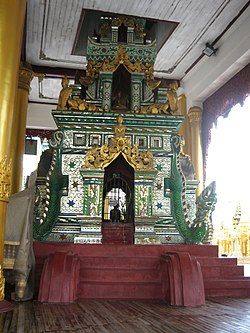Engineering:Glass mosaic

In Myanmar culture, glass mosaic (Burmese: မှန်စီရွှေချ) is a traditional form of glasswork where pieces of glass are used to embellish decorative art, structures, and furniture. Glass mosaic is typically divided into two subcategories, hman gyan si (မှန်ကြမ်းစီ) and hman nu si (မှန်နုစီ). The former is typically used to decorate the walls and ceilings of pagodas, while the latter is used to embellish furniture and accessories. The art form originated in the 1500s during the Nyaungyan era. Glass mosaic is often studded with gems and semi-precious stones.
History
Glass mosaic is a traditional Burmese mosaic made with pieces of glass, used to embellish decorative art, structures, and furniture.[1] Glass mosaic is typically divided into two subcategories, hman gyan si (မှန်ကြမ်းစီ) and hman nu si (မှန်နုစီ). The former is typically used to decorate the walls and ceilings of pagodas, while the latter is used to embellish furniture and accessories. The art form originated in the 1500s during the Nyaungyan era. Glass mosaic is often studded with gems and semi-precious stones.[2]
The National Museum of Myanmar exhibits hundreds of glass mosaic pieces like dolls, animal figures, chairs.[3]
Notable artists
- Isaiah Zagar
- Boris Anrep
- Miksa Róth
Materials
- Glass
- Gems
- Glue
- Grout
- Sponge
See also
- Mosaic
- Art of Myanmar
- Tiffany Glass and Decorating Company
References
- ↑ Lae Phyu Pya Myo Myint (2017-11-17). "A fragile tradition" (in en). The Myanmar Times. https://www.mmtimes.com/news/fragile-tradition.html.
- ↑ "Myanmar Mosaic Art". http://www.seasite.niu.edu/burmese/culture/myanmar_mosaic_art.htm.
- ↑ The Rough Guide to Myanmar (Burma). Rough Guides. 21 November 2017. pp. 142–. ISBN 978-0-241-33293-1. https://books.google.com/books?id=XfU5DwAAQBAJ&pg=PT142.
External links
 |

